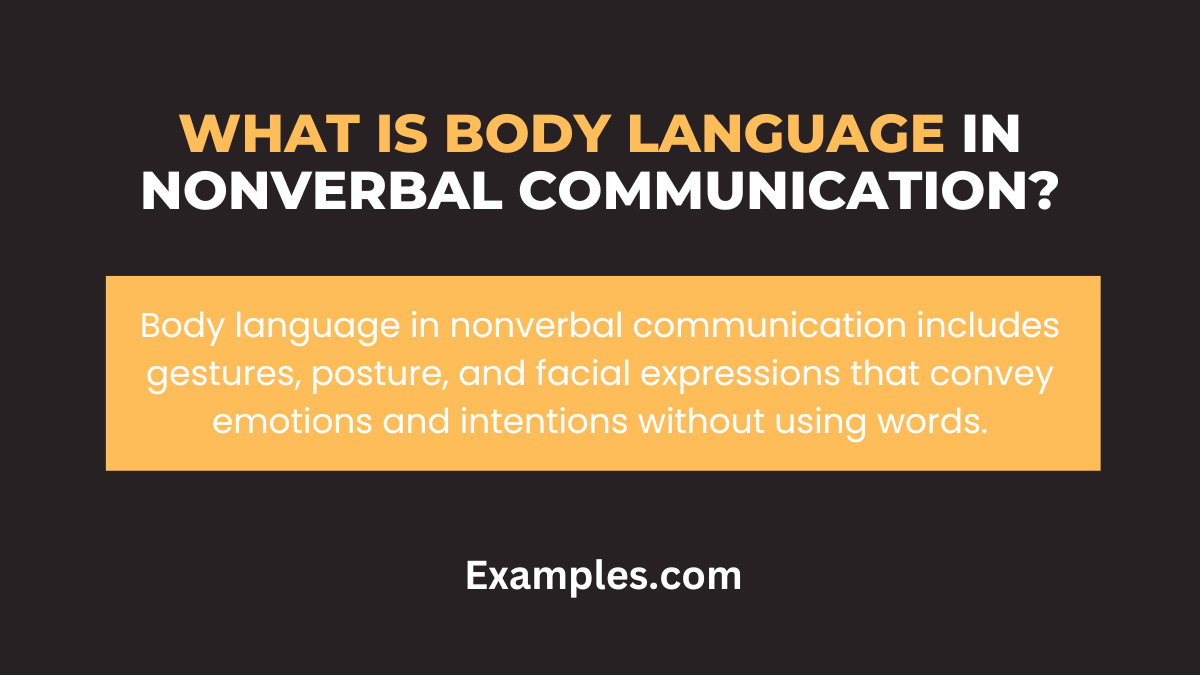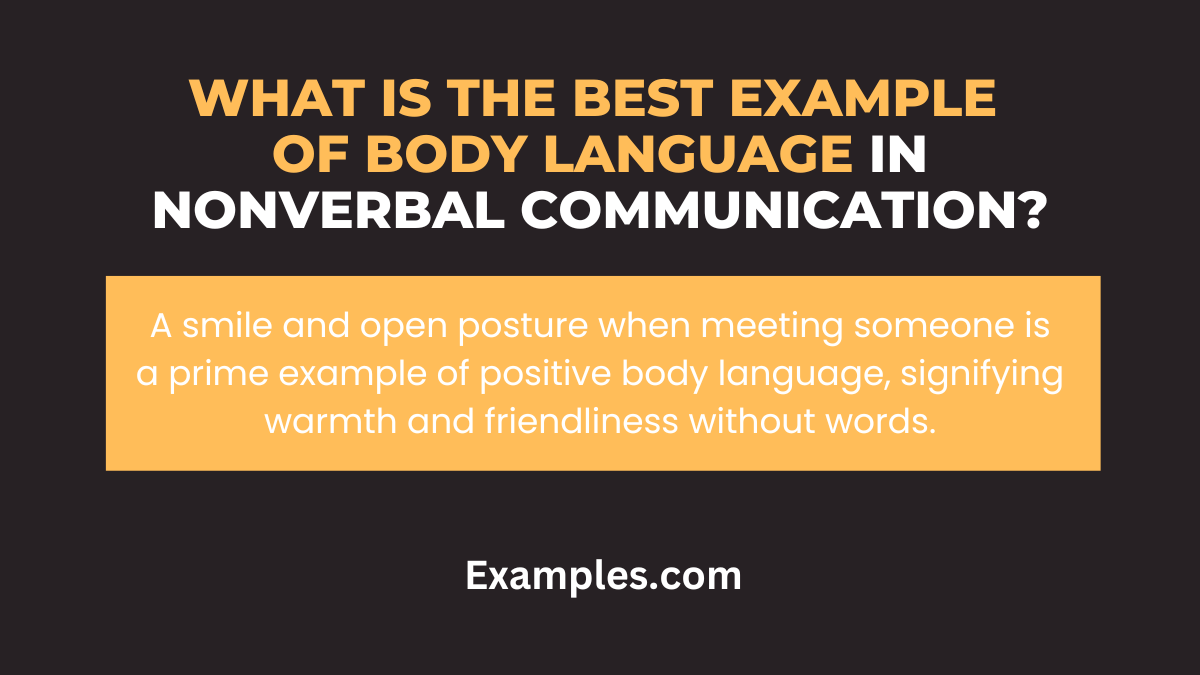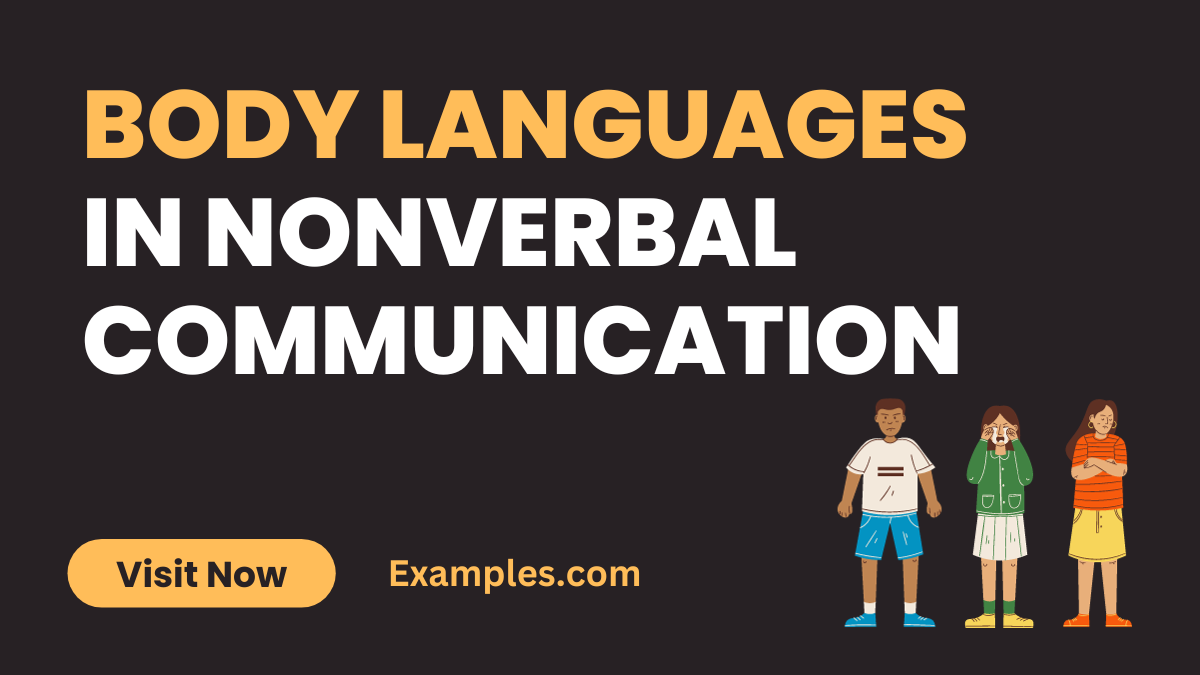29+ Body Language in Nonverbal Communication Examples
Delve into the intricate world of body language in nonverbal communication with our comprehensive guide. This essential aspect of human interaction goes beyond mere words, conveying emotions and intentions through gestures, facial expressions, and postures. Our guide, enriched with diverse communication examples, provides insights into interpreting and effectively using body language in various contexts. Enhance your interpersonal skills by mastering the nuances of nonverbal cues.
What is Body Language in Nonverbal Communication?

Body language forms a pivotal component of nonverbal communication, offering a window into unspoken emotions and intentions. It encompasses a range of physical expressions, like facial movements, gestures, and posture, which collectively convey messages without the use of words. Understanding body language is key to decoding the underlying messages in everyday interactions, enriching our communication skills.
What is the Best Example of Body Language in Nonverbal Communication?

One of the most striking examples of body language in nonverbal communication is the use of facial expressions. A smile, frown, or raised eyebrows can communicate a spectrum of emotions, from joy and approval to concern and disbelief. Similarly, gestures like nodding or shaking the head play a significant role in conveying agreement or disagreement, often transcending verbal language barriers. These nonverbal cues are instrumental in understanding and responding to others, highlighting the importance of body language in everyday communication.
30 Body Languages in Nonverbal Communication

Understanding body language is vital in enhancing effective communication. Approximately 55% of communication is nonverbal, emphasizing the importance of mastering nonverbal communication. Here are 30 unique body language cues, each with an explanation and example sentence, showcasing their significance in everyday interactions.

- Crossed Arms: Crossed arms in body language, a common nonverbal communication gesture, often indicates a defensive or protective stance. This gesture can suggest that a person is feeling closed off, skeptical, or resistant to what is being discussed or happening around them. However, context is key; in some cases, crossed arms might simply mean comfort or self-soothing. It’s essential to consider the entire body language and the situation to accurately interpret this gesture.
Example: When John crossed his arms, it suggested he wasn’t open to new ideas. - Direct Eye Contact: In nonverbal communication, direct eye contact plays a crucial role. It signifies attention, interest, and engagement in the conversation. Maintaining eye contact indicates confidence and honesty, fostering trust in interpersonal interactions. However, excessive or intense eye contact might be perceived as aggressive or confrontational in certain cultures.
Example: Her direct eye contact showed she was fully engaged in the conversation. - Tapping Feet: Tapping feet often reflect impatience, nervousness, or boredom. This involuntary action can signal a desire to leave or disinterest in the current situation. It’s a subconscious cue that reveals underlying emotions or attitudes that might not be verbally expressed.
Example: His tapping feet revealed his eagerness to leave. - Leaning In: Leaning in is a body language cue that shows interest and attentiveness. It’s a sign of active engagement in a conversation, indicating that the person is listening intently and values the interaction. This gesture can also signify agreement or a desire to be more involved in the discussion.
Example: Leaning in, she clearly expressed her attention to the speaker’s words. - Nodding: Nodding is a universal nonverbal cue indicating agreement, understanding, or approval. It’s a positive signal in communication, often encouraging the speaker to continue. Consistent nodding shows attentiveness and engagement in the conversation, fostering a sense of rapport.
Example: Nodding during the presentation, he indicated his approval. - Fidgeting: Fidgeting in body language often denotes discomfort, anxiety, or restlessness. It can be a sign of nervousness or distraction, indicating that the person is not fully engaged or is feeling uneasy in the situation. Fidgeting can detract from one’s ability to effectively communicate or listen attentively.
Example: Her fidgeting suggested she was either bored or nervous. - Smiling: In nonverbal communication, a smile serves as a universal sign of friendliness, openness, and positivity. It can indicate happiness, agreement, or a desire to connect with others. Smiling often puts people at ease and can be a powerful tool in building rapport and trust.
Example: His smile conveyed his satisfaction with the proposal. - Raised Eyebrows: Raised eyebrows in body language typically signal surprise, curiosity, or skepticism. They can indicate a person’s interest in a conversation or a reaction to unexpected information, and sometimes, they may express doubt or disbelief.
Example: Raised eyebrows showed her surprise at the unexpected news. - Hand on Chin: Placing a hand on the chin often signifies deep thinking or evaluation. In nonverbal communication, this gesture suggests that a person is pondering over something or considering their response, indicating a reflective or decision-making state.
Example: With his hand on his chin, he appeared to be deeply contemplating the question. - Shrugging: Shrugging is a common nonverbal cue indicating uncertainty, indifference, or lack of knowledge. It’s a universal gesture used to express that one doesn’t know the answer to a question or is unconcerned about a particular issue.
Example: Shrugging his shoulders, he expressed his lack of knowledge on the topic. - Palms Open: Open palms are a sign of honesty, sincerity, and submission in body language. This gesture is often used to convey that one has nothing to hide and is being open or truthful. It can also be a sign of welcoming or offering.
Example: Presenting with open palms, she conveyed her sincerity. - Mirroring: Mirroring in body language involves copying the gestures, posture, or movements of another person. It’s often subconscious and indicates empathy, rapport, or a connection with the person being mirrored. It’s a strong sign of understanding and alignment in communication.
Example: He mirrored her gestures, establishing a connection. - Head Tilt: A head tilt in nonverbal communication signifies interest, empathy, or curiosity. It’s often perceived as a friendly gesture, indicating that one is engaged in listening and is open to the conversation. It can also be a sign of confusion or contemplation.
Example: Tilting her head, she seemed puzzled by the explanation. - Biting Nails: In body language, nail-biting often signifies anxiety, stress, or nervousness. This habitual action can indicate that a person is feeling insecure or facing a challenging situation. It’s a self-soothing gesture that people unconsciously resort to in order to alleviate discomfort or apprehension.
Example: Biting her nails, she showed her anxiousness about the outcome. - Sighing: Sighing is typically a release of emotion, signaling exhaustion, frustration, or disappointment. In nonverbal communication, a sigh might indicate that the person is feeling overwhelmed or resigned to a situation. It can also be a sign of relief after a stressful experience.
Example: His sighs revealed his frustration with the ongoing delays. - Furrowed Brow: A furrowed brow is a classic indication of worry, concentration, or anger. In nonverbal communication, this expression is often associated with deep thinking, perplexity, or irritation. It suggests that the individual is intensely engaged with their thoughts or feelings.
Example: His furrowed brow indicated he was deeply concentrating on the problem. - Hands in Pockets: Placing hands in pockets can indicate a range of emotions, from relaxed comfort to hiding something, like nervousness or insecurity. It’s a casual stance but can also be perceived as a lack of confidence or defensiveness.
Example: With his hands in his pockets, he appeared relaxed yet slightly guarded. - Drumming Fingers: Finger drumming is commonly associated with impatience, boredom, or frustration. In nonverbal communication, it signals that the person is restless or eager to move on from the current situation. It’s an expression of internal rhythm or agitation.
Example: His drumming fingers on the table showed his impatience. - Foot Pointing: The direction in which the feet point can be revealing in nonverbal communication. Typically, when a person’s feet point towards someone or something, it indicates interest or attraction. Conversely, feet pointing away can signify a desire to leave or disinterest.
Example: Her feet pointed towards him, indicating her interest in the conversation. - Avoiding Eye Contact: Avoiding eye contact is often interpreted as a lack of confidence, interest, or honesty. In nonverbal communication, it can indicate discomfort, shyness, or evasion. However, cultural differences must be considered, as eye contact norms vary globally.
Example: Avoiding eye contact, she seemed to be hiding something. - Touching Face: This gesture often indicates stress, anxiety, or discomfort. People might touch their face when feeling uncertain or nervous, using it as a self-soothing action.
Example: Touching her face, she appeared to be pondering the question. - Folded Legs: Leg crossing can signify a defensive or self-protective stance. It might suggest the person is mentally, emotionally, or physically closed off from the situation or conversation.
Example: His folded legs suggested he was either comfortable or not open to discussing further. - Playing with Hair: Frequently seen as a sign of insecurity or nervousness. It can also be a self-comforting action or, in some contexts, a flirtatious gesture.
Example: Playing with her hair, she showed either nerves or flirtatious behavior. - Quick Nodding: Rapid nodding usually shows agreement or eagerness. It can also indicate that someone is impatient and wants the speaker to hurry up.
Example: His quick nodding showed his eagerness to add to the conversation. - Pursed Lips: Often a sign of disapproval or skepticism. It might indicate that the person is holding back a negative opinion or is doubtful about what is being discussed.
Example: Her pursed lips conveyed her skepticism about the idea. - Hands Behind Back: This gesture often indicates stress, anxiety, or discomfort. People might touch their face when feeling uncertain or nervous, using it as a self-soothing action.
Example: Walking with his hands behind his back, he exuded an air of authority. - Steepling Fingers: Commonly associated with confidence and self-assuredness. It’s often observed in people who are confident in their thoughts or are making a decisive point.
Example: Steepling her fingers, she displayed her confidence in her decision. - Yawning: Typically a sign of tiredness or boredom. However, it can also be a natural physiological response and might not always indicate disinterest.
Example: His yawning during the meeting indicated his boredom or lack of sleep. - Squinting Eyes: This can indicate skepticism or a critical assessment of the situation. Squinting might also occur in response to bright light or to view something more clearly.
Example: Squinting his eyes, he seemed to question the truthfulness of the statement. - Clapping Hands: Generally, a sign of appreciation or enthusiasm. It can also be used to signal agreement or to punctuate an exciting moment in a conversation or presentation.
Example: Clapping his hands, he expressed his enthusiasm for the project.

Why is Body Language Important in Nonverbal Communication?
Body language is a pivotal aspect of nonverbal communication, offering a window into a person’s emotions, intentions, and attitudes. It plays a crucial role in conveying messages without words, often revealing truths that verbal communication may conceal. Here’s why body language is so significant:
- Enhances Understanding: Body language can add depth to verbal communication, making the message more understandable. Gestures, facial expressions, and posture contribute to a fuller understanding of the spoken word.
- Reveals True Emotions: Often, what people say and what they truly feel can be different. Body language can expose genuine emotions like nervousness, confidence, frustration, or enthusiasm.
- Aids in Building Rapport: Effective body language, such as maintaining eye contact in nonverbal communication, fosters trust and connection. It helps in building rapport and strengthening relationships.
- Facilitates Effective Communication: In scenarios where verbal communication is not possible, like in a noisy environment or in cross-cultural situations, body language serves as a critical communication tool.
- Improves Personal and Professional Interactions: In both personal and professional settings, understanding and using body language effectively can lead to more successful interactions and negotiations.
How to Improve Body Language in Nonverbal Communication?
Improving body language is key to enhancing your overall communication skills. Here are some strategies:
- Maintain Eye Contact: Eye contact signifies attention and interest. However, it’s important to balance it well to avoid staring, which can be uncomfortable.
- Use Gestures: Gestures can emphasize points and express enthusiasm. However, they should be natural and not overly dramatic.
- Monitor Facial Expressions: Your facial expressions should align with your words. Smiling, for instance, can make you seem approachable and friendly.
- Adopt an Open Posture: Avoid crossing arms or legs, as this can appear defensive. An open posture indicates openness and receptivity.
- Practice Active Listening: Nodding and leaning slightly forward shows that you are engaged and listening actively.
- Control Fidgeting: Excessive fidgeting can be distracting. It’s important to be aware of and control nervous habits.
Role of Body Language in Nonverbal Communication
Nonverbal communication, a fundamental aspect of human interaction, encompasses various forms that extend beyond spoken or written language. Among these, body language stands out as a crucial and pervasive method of conveying messages and emotions without words. This detailed exploration examines the multifaceted role of body language within the broader spectrum of nonverbal communication.
1. Expressions and Emotions
Facial expressions, an integral part of body language, effectively communicate a wide range of emotions. From happiness and surprise to anger and sadness, our faces can convey messages more powerfully than words.
2. Gestures and Symbolism
Gestures, ranging from simple hand movements to complex sequences, often accompany speech, adding emphasis or providing additional information. They can be culturally specific and are an essential aspect of nonverbal communication.
3. Posture and Attitude
Posture, the way we hold our bodies, is a silent announcer of our attitudes and feelings. Open postures indicate approachability and confidence, whereas closed postures might suggest defensiveness or disinterest.
4. Eye Contact and Engagement
Eye contact is a potent tool in nonverbal communication. It can signify attention, interest, or even intimidation. Prolonged eye contact or lack thereof can drastically alter the tone of an interaction.
5. Proximity and Personal Space
The physical distance maintained in interactions, known as proxemics, communicates levels of intimacy and comfort. Different cultures have varying norms regarding personal space.
6. Touch and Connection
Haptics, or the use of touch, is a powerful nonverbal tool. A handshake, a pat on the back, or a hug can communicate a range of emotions from support to dominance.
7. Physical Appearance and First Impressions
Our choice of clothing, accessories, and overall grooming contribute to the impressions we make. These choices can communicate social status, professionalism, or even personal values.
8. Movement and Dynamics
The way we move, our walking style, and our gestures contribute to our overall body language. These movements can express confidence, nervousness, or a variety of other states.
9. Regulating Conversations
Body language plays a critical role in regulating the flow of conversations. Nods, shifts in posture, and facial expressions can signal when it’s another person’s turn to speak or when a topic is of particular interest.
10. Cultural Variations
It’s important to remember that body language can vary significantly across cultures. What is considered polite or normal in one culture might be offensive in another.
Body language is a vital component of nonverbal communication. It encompasses a diverse range of human behaviors, from facial expressions and gestures to posture and eye contact. Understanding and effectively utilizing body language can greatly enhance communication skills, as it offers a deeper insight into unspoken feelings and intentions. Whether in personal interactions or professional settings, being attuned to these nonverbal cues can significantly improve understanding and rapport among individuals.
In the intricate world of nonverbal communication, body language stands as a crucial element, offering deep insights into unspoken feelings and intentions. The ability to interpret and effectively utilize body language significantly enhances one’s communication skills, both in personal and professional contexts. It goes beyond mere words, encompassing a wide array of human behaviors such as facial expressions, gestures, posture, and eye contact??.
For those seeking to further explore and understand the nuances of body language, the Psychology Today website (https://www.psychologytoday.com) is an invaluable resource. It provides in-depth articles and studies on various aspects of body language and nonverbal communication, authored by experts in the field. This site can help readers develop a more profound understanding of how body language affects interpersonal interactions.
Additionally, the Harvard Business Review (https://hbr.org) offers insightful articles on the importance of body language in leadership and professional settings. Their content, backed by research and expert opinions, gives practical advice on how to use body language effectively in different business contexts, from negotiations to team management.
Understanding body language is more than just recognizing nonverbal cues; it’s about comprehending the complex interplay of human emotions and intentions that govern our interactions. By becoming more attuned to these subtle signals, individuals can significantly improve their ability to understand and connect with others, making every interaction more meaningful and effective.



